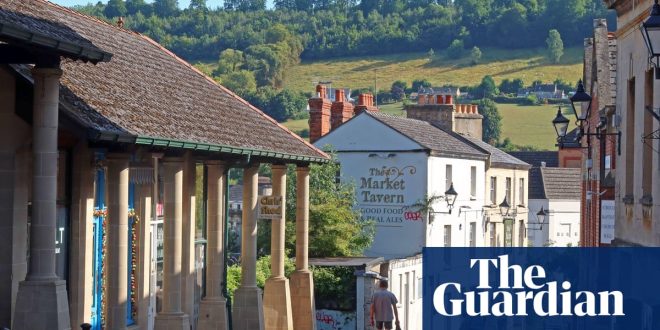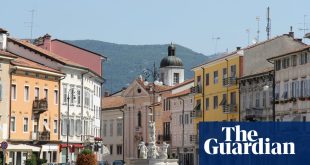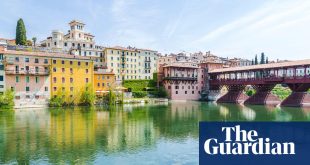Think of the Cotswolds and you’ll probably conjure up images of chocolate-box villages in honeyed stone surrounded by dreamy patchworks of green fields, possibly farmed by Jeremy Clarkson. The region covers parts of six counties – most is in Gloucestershire and Oxfordshire, but also corners of Warwickshire, Wiltshire, Worcestershire and Somerset – is a postcard-pretty holiday destination, and has been a hub for the wealthy since the heyday of the wool trade in the late middle ages.
More recently, the region I call home had a PR coup when Taylor Swift and her entourage based themselves near Chipping Norton this summer for her London tour dates. Then there are the stars of Bridgerton filming on the streets of nearby Bath, and traffic jams outside Clarkson’s farm shop, made famous by his TV show.
But since I moved here in 2022, I have been searching out the wilder side of the Cotswolds, because to write off the region William Morris called “heaven on Earth” as a playground for the posh does it a disservice. The largest “national landscape” (the new name for areas of outstanding natural beauty) in England and Wales, the Cotswolds is also a surprising treasure trove, home to Roman snails, ancient stone circles and crowds busy chasing cheese down hills. And it’s all crisscrossed by more than 3,000 miles of walking trails. Beyond the pretty villages besieged by coach tours, there are real communities, carefully curated historic gems, a thriving art scene and a clutch of proper pubs.
Start by heading south from the green-welly enclaves (such as Castle Combe, Bibury and the Slaughters, both Lower and Upper) to Stroud. The town this newspaper called “one of those rare spots in the countryside where Guardian readers can be out and proud” is a liveable place, and a delightfully alternative one. Stroud is home to climate protest group Extinction Rebellion, the world’s first carbon-neutral and only vegan football club (Forest Green Rovers), what claims to be Britain’s first organic cafe (Woodruffs on the High Street) and a fabulous Saturday farmer’s market, launched in 1999 by Jasper Conran and Isabella Blow. Stroud sits in the heart of the Five Valleys – Painswick, Slad, Toadsmoor, Chalford and Nailsworth – surrounded by rolling green hills that are perfect for exploring on foot, perhaps with a stop for refreshments at Woodchester Valley Vineyard, or at one of my favourite pubs, the Woolpack in Slad, where Cider With Rosie author Laurie Lee once propped up the bar.
The ancient commons surrounding Stroud are still grazed by cattle, and are part of the National Trust’s Stroud Landscape Project, a grassland creation scheme helping to reintroduce endangered animals and plants. You may also come across a big top festooned with lights – this is Giffords Circus, a “vintage village green circus” and travelling restaurant founded in Stroud that tours the south of England in the summer. The Alfresco Film Company hosts summer film nights at venues including Cotswold Airport, 12 miles away, screening classic movies in the shadow of a defunct British Airways Boeing 747.
The Cotswolds has, of course, long been a coveted place to live – the Romans settled here in AD43. Beautifully preserved Chedworth Roman Villa is now a National Trust site. The detailed mosaic floors, bath houses and “nymphaeum” (a shrine fed by spring) feel as though they were deserted by their original residents mere moments ago – and they’re still inhabited by Roman snails (Helix pomatia) brought here as a delicacy more than 1,800 years ago. Less well known but as eerily evocative is North Leigh Roman Villa, which is free to wander around (via a muddy track) and still has a beautifully intricate mosaic floor from the fourth century.
It’s possible to follow in the footsteps of the Romans by walking their ancient paths. The Fosse Way was once the longest Roman road in Britain, linking Exeter to Lincoln, and many sections have been swallowed up by modern highways. But fragments remain in the Cotswolds, such as a 25-mile stretch from Tetbury to Bath.
Of the 3,000 miles of public footpaths that wind through the Cotswolds the longest is the Cotswold Way. This national trail starts in Chipping Campden and winds its way south for 102 miles to end in Bath, a few miles to the south of the region. It’s split into 15 sections, but if I could only walk one, I’d pick the nine-mile route from Birdlip to Painswick. It passes beech woodlands, an iron-age hill fort and Cooper’s Hill, where, each May, a 5,000-strong crowd gathers at the dizzyingly steep slope to watch participants chase a wheel of double gloucester to the bottom during the annual cheese rolling event. However you get down the hill, you’ll end up in Painswick, often referred to as “Queen of the Cotswolds” for the beauty of its buildings and its 18th-century Rococo Garden, which puts on art trails and theatre productions in the summer.
North of my home valleys the villages take on a more Poshtershire honeyed hue, but there are still lesser-known delights to seek out at the top of the Cotswolds. Stow-on-the-Wold’s mellow stone streets are much photographed but the market town is also home to ancient yew trees, a Gypsy horse fair each May and three foodie pubs: the Porch House, which claims to be England’s oldest inn and serves a fantastic Sunday roast; the Old Butchers, which specialises in nose-to-tail cooking; and the Wild Rabbit, a posh eco-pub offering seasonal supper clubs.
Chipping Norton may now be best known for Clarkson and the A-listers escaping to Soho Farmhouse, but it’s also home to a literary festival (in April); indie bookstore Jaffé & Neale; the much-loved Chippy Lido, which hosts sunset swims; and a different kind of rock group – the Rollright Stones, 5,000-year-old monoliths said to be a king and his courtiers for ever petrified by a witch.
Camping is a good way to experience the wilder side of the Cotswolds. Abbey Home Farm offers back-to-basics meadow camping next to its organic farm shop, which sells homegrown vegetables and meat. At the T Barn there’s a cosy woodland cabin with hot tub as well as off-grid camping complete with fire pits. The Wildings is a calm, child-friendly campsite a minute’s stroll from Bourton-on-the-Water. And to really escape the crowds, Peter’s farm, bookable on Hipcamp, has no facilities but campers can pitch a tent or park a van anywhere on 45 hectares (110 acres) of land.
 Top Naija News – Nigeria News, Nigerian News & Top Stories Top Naija News – Nigerian Newspapers, Nigerian News. topnaijanews is a daily Nigerian newspaper covering Latest News, Breaking News, Entertainment, Sports, Lifestyle and Politics.
Top Naija News – Nigeria News, Nigerian News & Top Stories Top Naija News – Nigerian Newspapers, Nigerian News. topnaijanews is a daily Nigerian newspaper covering Latest News, Breaking News, Entertainment, Sports, Lifestyle and Politics.




